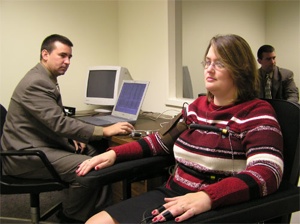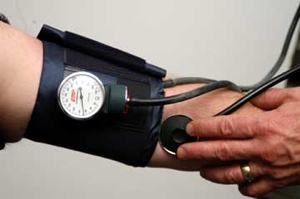- Refuse
Refuse a polygraph test if you can. For pre-employment screenings this will almost certainly ensure that you don’t get hired, but it probably will not get you fired in most circumstances. In the U.S., private sector employers may not terminate employment or take other such adverse actions based solely on a polygraph refusal (this protection usually does not cover government employees). If your polygraph is part of a criminal investigation, you have a right to refuse (in the U.S., at least), and you should refuse, even if you are innocent, because of the possibilities of a “false positive.” Refusal to submit to a polygraph is generally not admissible in court, and polygraphs themselves are always inadmissible.
- Study!
Learn about polygraphs. Since you’re reading this article, you’re on the right track, but if your career or court case depends on it, wouldn’t you do as much research as you can? Answer truthfully, now. The most important thing to know is that polygraphy is not an exact science. In fact, to the extent that it is a science at all, it is one in its infancy and one which frequently produces incorrect results. 8. Think Ahead
Find out what the tester is looking for. A polygraph examination is administered to help find out specific information, such as whether you’re a spy or whether you’ve used drugs. Prepare yourself in advance by thinking about what confessions they are looking for, what things you cannot admit. The polygrapher will ask you many uncomfortable questions, but only certain ones are important. If your test is prompted by a specific incident, you probably know what the examiner is looking for, but for pre-employment screening tests and the like, research the company or agency’s policies to determine what you can and cannot admit. 7. Think of it as a job interview
Approach your whole “polygraph day” as a test. Treat the polygraph examination as an extreme job interview. Dress conservatively and appropriately, and try to make a good impression before the test, and be sure to arrive on time—and, except in the direst of circumstances, do not reschedule or attempt to postpone the exam. You wouldn’t fidget, do anything suspicious, or pick your nose during a job interview, would you? Well, the polygraph is an extreme interview because your every move is very likely being observed the moment you arrive at the testing location. There may be hidden cameras in the waiting room and the restrooms, and there is almost certainly a camera or two-way mirror in the polygraph room. Your polygraph examination begins long before you are hooked up to the machine, and ends only when you’ve left the testing location.
- Identify the Questions
Identify the types of questions you are being asked. There are three basic types of questions you will be asked: relevant, irrelevant, and control. Irrelevant questions are those that are obvious, such as “What is your name” or “Have you ever eaten pasta?” Relevant questions are the important ones, such as “Did you leak that memo to the media,” “Have you ever stolen money from an employer,” or “Have you ever sold drugs?” Control questions are those against which your reactions to relevant questions will be compared. These are usually questions to which (just about) everybody can answer “yes” but which everybody is uncomfortable honestly answering, such as “Have you ever cheated in a game,” “Have you ever told a lie, even a tiny white lie, to your spouse,” or “Have you ever stolen anything?” Before the test the polygrapher will typically read you all the questions you are going to be asked. This is a good time to mentally sort out the types of questions.
- Stick to the Topic
Don’t admit anything relevant. The job of polygraphers is to extract confessions, and in one way, the whole examination is a complex ruse to trick you into confessing something. Never confess relevant information. No matter what the lines on the chart look like, nothing is more certain or damaging than your confession. The polygrapher will most likely try to convince you that he or she can “see” a lie in your polygraph, even if there’s nothing abnormal there. Don’t fall for it. Obviously, however, you want to appear to be an honest person in general, so don’t be afraid to make minor admissions to control questions (see below)—just make sure you don’t admit anything in these that can invite further questioning or that may be construed as relevant.
- Essential information only
Say only what you need to. “Yes” or “No” answers should be all you need for most of the test. Resist the temptation to explain your answers or to go into details, although the polygrapher may try to get you to do so. Be courteous and cooperative, but do not offer any more information than is absolutely necessary. Answer questions firmly, seriously, and without hesitation. This is no time to joke around or try to be crafty. You want to appear earnest, cooperative, and resolute. 3. I KNOW NOTHING AT ALL!
Conceal your knowledge of polygraphy. The polygrapher may ask you, often before or after the test, if you’ve done any research on polygraph tests or what you know about them. Do not disclose that you’ve done extensive research, and act as though you don’t know much about polygraph examinations but that you do believe polygraphy to be a science and polygraphs to be reliable (or at least do not exhibit any doubt as to their reliability). The polygrapher may try to trick you by mentioning certain technical terms and acronyms, such as, “Your test came back NDI.” While you know (or will now know) that “NDI” means “no deception indicated,” you need to act as though you have no idea what it means. Too much knowledge of the process may make the polygrapher think you’ve got something to hide, even if you don’t.
- Manage your blood pressure
Throw off the machine’s reading of the control questions by changing your blood pressure and heart rate. It’s difficult to do, but with practice, the next few methods and countermeasures will prompt your body to do so. Do some of the following when replying to control questions: Develop a breathing strategy. Throughout the test (except during control questions) maintain a normal breathing rate of 15-30 breaths per minute. Do not breathe too deeply. Then alter breathing rate with control questions. You can make it faster or slower, you can hold your breath for a couple of seconds after an exhalation, or you can breathe more shallowly, for example. Do this for 5-15 seconds, and return to your normal breathing pattern before the next question. As explained above, the polygrapher will compare your physiological responses to control questions to your responses to relevant questions. If the deviation from normal during control questions exceeds the deviation from normal during relevant questions, you will pass. If, however, you react more to a relevant question than to control questions, the polygrapher will perceive (rightly or wrongly) that you are lying in response to something relevant—you will fail the polygraph. Do math in your head. During control questions do something mentally complex. For example, count backwards in your head as quickly as possible or do some quick long division, as you are answering the question. Think about something exciting or frightening; think of things that make you ecstatic, fearful, or frustrated. Bite your tongue. Bite the side of your tongue hard enough to cause pain, but not so hard as to draw blood. Practice this in a mirror to be sure the polygrapher cannot detect it. This is highly effective, but may be detectable if you have to speak for an extended period, because you can’t bite while you’re speaking. Only use this method if you can give a quick “yes” or “no” response, which, luckily, will be most of the time. Insert a small nail or tack in the toe area of your shoe and press down on this during the control questions to elicit a pain response. This is a sound method, but it is easily defeated if the polygrapher asks you to remove your shoes. Contract your anal sphincter muscle when a control question is asked. While also highly effective, this method may (or may not) be discovered with the use of pressure-sensitive seat pads that are now commonly used.
- Handle the after-event
Handle the post-test interview. After you’re disconnected from the machine, the polygrapher may leave you in the room for a while and come back. The polygrapher may then claim to “know” that you are lying about something. This is a trick. Remain calm, firmly, but politely repeat your denial, and don’t change or argue your answers, even in the slightest way. Decline extended post-test interviewing if possible. This article is licensed under the GFDL. It uses material from the WikiHow articles: How to cheat a lie detector Read More: Twitter Facebook YouTube Instagram
























